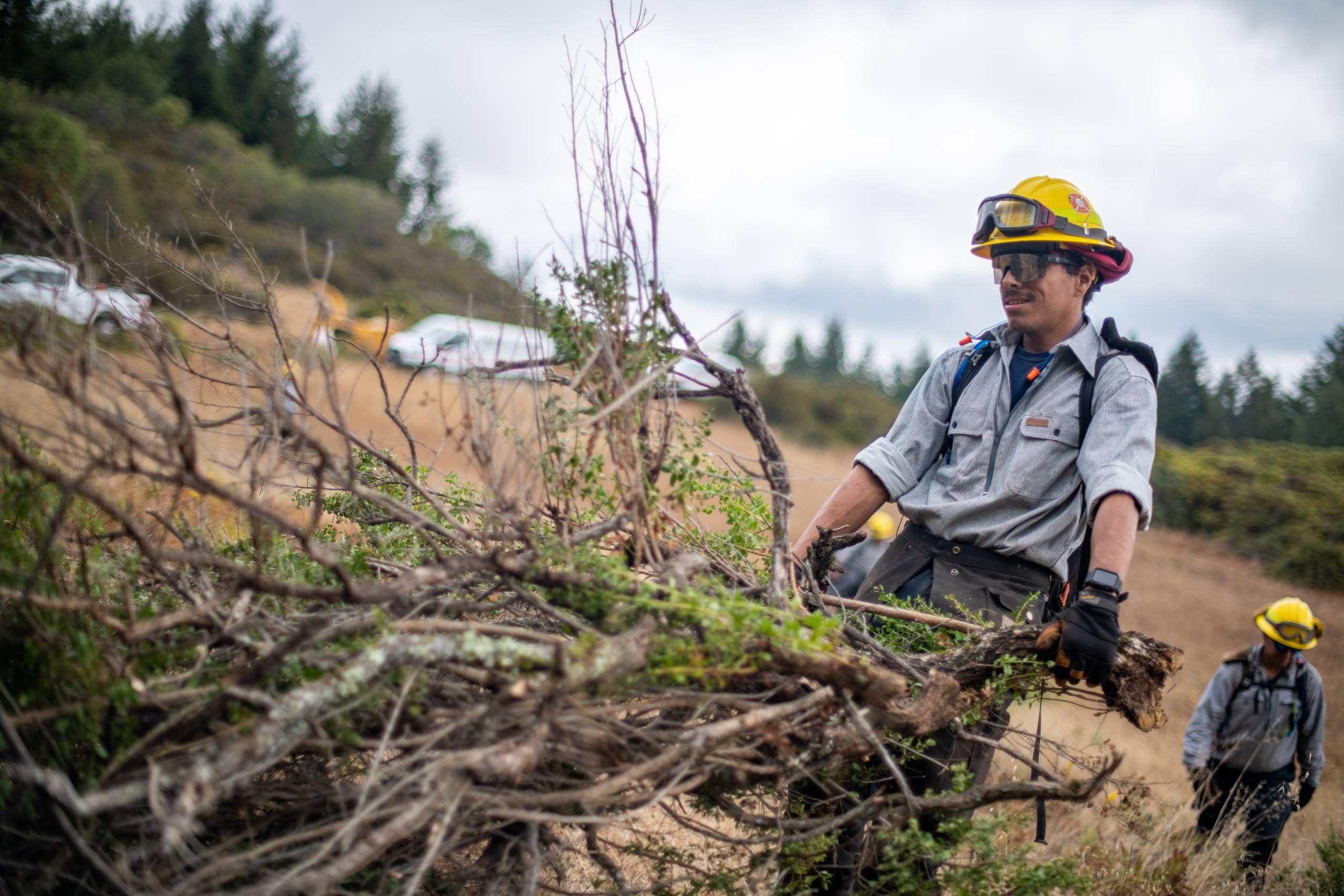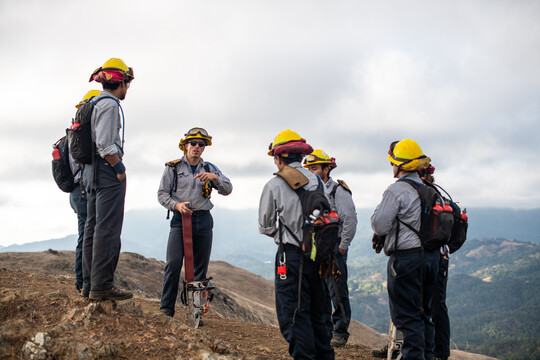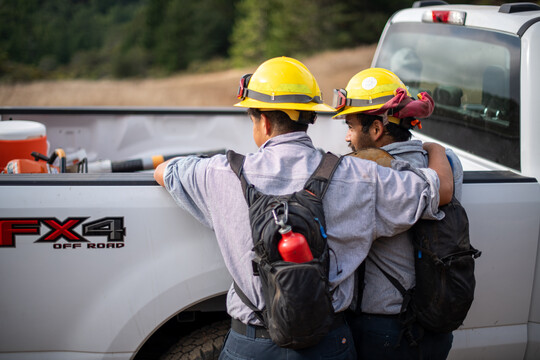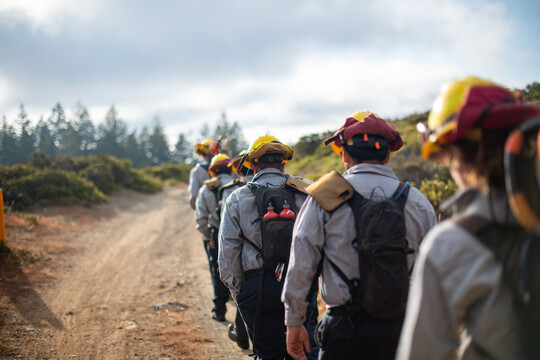All morning, Armando Jimenez and Jesus Chavez shoveled loads of brush into a wood chipper, the sharp smell of bay trees wafting around a playground, parking lot and baseball field in San Anselmo’s Memorial Park. If a fire were to approach, it would approach from a steep, wooded hill that was, until this morning, covered in eucalyptus, acacia and other brush but now looks clean-shaven, cleared of small trees, branches and twigs — all good fuel for a fire.
Thanks to the work of Jimenez and Chavez, if a spark were to hit this hillside and start a fire, it is now much less likely to climb up the brush like a ladder and start a crown fire in the tops of the big trees, threatening nearby homes.
Jimenez and Chavez, and the other members of their crew, are part of the first cohort of Fire Foundry, a job-training program seeking to change the way firefighters are recruited in Marin County — one of California’s richest counties, yet also one of its most segregated.

The program offers full-time employment (mostly clearing vegetation and other fuels work to protect against future fires), temporary housing at the fire station, assistance with food, mental health support, tutoring, free uniforms and boots, free tuition at the College of Marin and training in using emerging fire technology, like remote sensing programs and predictive services. The goal is to get more people of color and women into the Marin County Fire Department and the field at large.
Laying his hard hat aside, Jimenez sits down at a wood picnic table. “I really want to see more minorities in the fire service,” he said. “That’s the major thing [that] made me want to join.”
The 21-year-old was born and raised in Mexico and came to the U.S. in 2010.
Both in Marin County and nationwide, fire department diversity is dismal. Of the county’s 80 full-time firefighters, nearly 83% are white men. Approximately 7.5% are white women, an equal percentage are Latino, and Asian firefighters account for just 2%. None of the department’s full-time firefighters are African American. In the county, 3% of the population is Black, 16% Latino and 6% Asian. Slightly more than half the population is female. According to the Bureau of Labor Statistics in 2019, 96% of U.S. career firefighters were men and 82% were white.
The feeder programs that funnel people into fire academies are largely the same. That’s despite a body of research literature (PDF) suggesting that communities are better served if first responders look like the community they’re serving.
“We’re trying to break that mold,” said Marin County Fire Chief Jason Weber, who initiated the idea for Fire Foundry, which helps trainees build the skills for long-term, well-paying jobs. “We’re trying to break systemic cycles of poverty, generational poverty, and that has to do with the importance of a sustainable wage career.”
The reality of climate change, said Rhea Suh, current president of the Marin Community Foundation, is that the adaptation and mitigation it’ll require will incur phenomenal costs. There’s an opportunity, she said, for governments and organizations to connect middle-class, union jobs — firefighters, pipe fitters, track workers — with people who need them.
“We know the fires are coming. We know sea level rise is happening. Why can’t we really think about the pipeline for these positions?” she said. “These can be the great jobs of the next century.”

Forged by many hands
It was during the turbulent times of 2020 — COVID-19, a presidential election, the worst wildfire year in recorded history, and a summer of racial reckoning that followed a white Minneapolis police officer killing George Floyd, a Black man — that discussions about Fire Foundry gained speed.
It took cooperation from a suite of partners to form the program. Those partners included Conservation Corps North Bay, College of Marin, Marin County, the Marin Wildfire Prevention Authority and others.
“It was a moment of momentum. All of these groups came together to build something,” said Sofia Martinez, equity analyst with Marin County, one of the co-founders of the program. “People are calling for representation in all sectors of life. Especially when it comes to emergency medical response or disaster response in general, they want to see people out in the field and they want to be interacting with people that understand their lived experiences.”
College of Marin, Stanford University and UC Berkeley also are partners in Fire Foundry. Martinez said the program benefits from their researchers who are “passionate about changing the way things have historically been done,” and from proximity to Sonoma and Napa counties, where the destructive Glass, Kincade and Tubbs fires burned.
Sukh Singh is lab manager at the UC Berkeley Disaster Lab, which seeks to use technology and innovation to address the problems facing humankind. He heard about the idea for the program in early 2021 and was part of the development team, designing marketing and communications materials and helping with recruitment.
“I immigrated from India,” Singh said. “I had never thought about becoming a firefighter.”
He was surprised to learn firefighters can make good money, especially for those who also administer emergency medical aid, and thinks that if more people knew, they might be drawn to the profession. Depending on the city or county, starting salaries for a firefighter paramedic can range from $80,000 to $140,000 a year.
Knowing that could have made the job more interesting to him growing up, Singh said. “And it would have been one of the things [that] could have convinced my family,” Singh said, “because we were very low-income growing up — that this could be a valid and important career field.”

Successes and loss
Fire Foundry is in its infancy and is untested. This year the program was not able to retain the full roster of female recruits. Seven started the program and two remain: One is now in the Santa Rosa Junior College Firefighter Academy. The other took a job doing defensible space inspections in the Marin County Fire Department.
Nationwide 96% of career firefighters are men, so increasing the ranks of women is a high priority for Fire Foundry. Architects of the program are planning to make some changes for next year: more flexibility in schedules, earlier and more frequent mentoring and more tailoring to individuals’ specific needs. Weber hopes that changes will help with retention and that the program catches on around the state.
Observers and supporters within the county are heartened by the wraparound approach Fire Foundry offers compared to other training programs.
“I know the [conservation] world really well,” said Suh, of the Marin Community Foundation, “and it is and always has been dominated by white men.” She formerly led diversity programs at the Department of the Interior, nominated by former President Barack Obama.
“I am fascinated that there are people on the ground like the Marin fire chief who’s saying to himself, without any kind of outside pressure, ‘We have to figure out a sustainable way to maintain our pipeline and […] if we are going to attract more people of color, more women, we need to have a different attitude and posture.'”
For his part, Chief Weber hopes the model for the program gains ground. They tried to build it using mostly existing funds and staff.
“We’re trying to create something new that can be either reproduced or recreated across the state,” he said.
Back at the wood picnic table, Jesus Chavez, 23, said school was a struggle for him in the past. Now, he’s back in classes learning to be an EMT. “I have to face it. It’s something that I want to do — to become a better person for myself,” he said.
As a kid he wanted to join the fire service, but didn’t know how to get in. He applied for Fire Foundry after seeing an Instagram ad. He fell in love with the hard work outside, alongside other firefighters.
“They get down and dirty,” he said. “I like that. Everyone’s close, like a whole family.”

